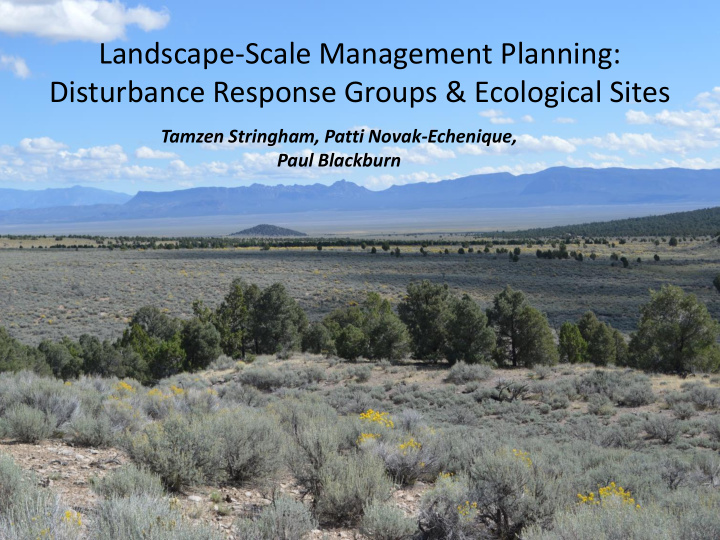



Landscape-Scale Management Planning: Disturbance Response Groups & Ecological Sites Tamzen Stringham, Patti Novak-Echenique, Paul Blackburn
Scale Issues & Ecosites • MLRA 25 – 9.6+ million ac – 69 eco sites • MLRA 28B & 28A – 18.7+ million ac – 160+ eco sites • MLRA 24 – 7.6+ million ac – 54 eco sites • MLRA 23 – 3.6+ million ac
2011 2012 MLRA Acres Burned 23 724 793,333 24 112,809 80,383 25 39,352 145,331 28B 2,290 107,909
Oregon Greater Sage Grouse Habitat
Planning Challenges Core Habitat > 1 million acres 2 MLRA’s 2 States; multiple BLM Offices Budgets
Developing Disturbance Response Groups
Disturbance Response Groups Key Concepts • Group of ES’s that respond similarly to……. – Rate of response may vary – End point is same • STM is essentially the same • ‘Ecological Dynamics’ describes minor differences
State-and-Transition MODEL Ecological Process Based Model MINIMUM SCALE FOR STATE = ECOLOGICAL SITE State B Plant Community Phase Restoration At-Risk Phase At-Risk Threshold Phase State A State C
STM Development Process Disturbance Response Groups • Assemble the core TEAM • Invite others to participate in office / field events • Teach the STM concepts to the core TEAM – Multiple times; office & field
Range Ecologist / STM Experience Range / Plant GIS Soils Range / Plant
What is “process - based” thinking? • Understanding that what we see is created by the functional capacity of ecological processes • STMs describe ecological dynamics
What is “process -based thinking? • What is driving the creation and maintenance of what I see? • Process = amount per time (rate) – Infiltration rate – Nutrient cycling – Energy capture – Soil erosion – Etc.
Ecological Dynamics Response to Disturbance • Response to disturbances – Specie specific? • Know individual plant response – Dynamic soil properties • Vary by soil texture? • Resilience – Climate – Soils – Plants
STM Development Process Disturbance Response Groups • MLRA or LRU scale – Build understanding of the climate, soils, plants • Soil scientist teach geology, soils, etc • GIS specialist create data layers of soil map units; fire events; roads; public / private land; etc.
STM Development Process • Range sites – Describe Reference Condition = State 1 – Describes landscape, climate, soils, plants, production – Describes response to disturbance • Team analyzes each site & determines how it responds to disturbance • Group sites
STM Development Process Disturbance Response Groups • Grouping process leads to building blocks for STM – Discussion involves • Soils and soil differences within groups – resilience • Plant species response to numerous disturbances • Response to repeated disturbance • Modal site – greatest amount of acres mapped or – typical disturbance response of the group
Scale Issues & Ecosites • MLRA 25 – 69 eco sites – 12 DRG’s – 115 field notes • MLRA 28B & 28A – 160+ eco sites – 32 DRG’s – 310 field notes • MLRA 24 – 54 eco sites – 11 DRG’s – 74 field notes • MLRA 23 – 85 eco sites – 24 DRG’s – 78 field notes to-date
MLRA 24 NV Disturbance Response Groups Group 1 ≈ 1.9 M ac Wyoming Sage Loamy 8-10 Modal ≈ 1.0 M ac Group 2 ≈ 1.6 M ac Salt Desert Shrub Loamy 5-8 Modal ≈ 1.5 M ac
Sagebrush Cover Change
80% of ranch has burned 1 time; 30% 2 times; 9% 3 times 1990-2012
Cost of Rehabilitation Seeding = $1 million
Cobbly Claypan Claypan 12-16
1. What phase before fire? 2. Management after fire? 2.2a = with time Sagebrush will Re-establish
Squaw Valley Live Shrub Density 2014 600 Green rabbitbrush 400 Plants per hectare Rubber rabbitbrush 200 Low sagebrush 0 Big sagebrush -200 Kochia -400 -600 Control Dormant Growing Treatment Average Annual Production by Functional Group Squaw Valley 2014 1200 1000 Sandberg bluegrass Pounds per acre 800 Annual Grass 600 Perennial Grass 400 Forbs 200 0 Control Dormant Growing Treatment
Conclusion • DRG’s Landscape Scale / ES scale model • Incorporate Expert Knowledge & Data • STM robust tool for decision making
Management Applications • Wildlife habitat • Monitoring – BLM AIM strategy • Grazing Management • Emergency Stabilization / Monitoring • Drought Decisions
Timeline • MLRA 24 Models: Complete – tstringham@cabnr.unr.edu • MLRA 25 Models: June 30, 2015 • MLRA 28A and 28B: Complete • MLRA 23NV: underway • MLRA 26: underway • MLRA 23 Oregon: Complete – tstringham@cabnr.unr.edu
Recommend
More recommend